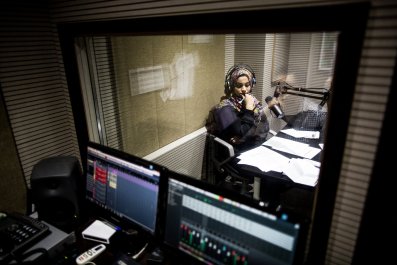In the waning days of July,This American Life host Ira Glass went to see a performance of King Lear in Central Park. Many consider the tragedy of the ailing monarch to be Shakespeare at the apogee of his power. Not Glass. Not even close. Glass took to Twitter to complain that Shakespeare was "not good. No stakes, not relatable. I think I'm realizing: Shakespeare sucks."
@JohnLithgow as Lear tonight: amazing. Shakespeare: not good. No stakes, not relatable. I think I'm realizing: Shakespeare sucks.
— Ira Glass (@iraglass) July 28, 2014
A later tweet charged that Shakespeare is "unemotional." Condemnation of Glass quickly followed, much of it focused on his apparent belief that "relatability" is an artistic virtue. In a widely-shared post, New Yorker staff writer Rebecca Mead argued that relatability is an implicit requirement that art be a "flattering confirmation of an individual's solipsism."
The relatability scourge has no home as welcoming as the American classroom, particularly in the inner-city, where teachers are incessantly exhorted to make the subject matter matter—whether it be algebra or grammar. These students can only absorb knowledge, the noxious strain of thought goes, if it is immediately relevant to them. Otherwise, they will respond just as Glass did. The late young-adult author Walter Dean Myers, for example, once explained in The New York Times that he set his novels (Street Love, Dopesick, Lockdown, etc.) in the inner city so that his young readers could achieve "a validation of their existence as human beings." Presumably, no such validation is possible through Melville, or, for that matter, Ellison.
Myers's philosophy permeates the inner-city classroom (as do his books). I remember, during my first year of teaching middle-school English in an impoverished section of Brooklyn, the senior teacher in charge of the class, Ms. D., thought that our seventh-graders should watch, during instructional time, Everybody Hates Chris, the short-lived Chris Rock sitcom about his hapless Brooklyn childhood. I gently pointed out to Ms. D. that while the show was funny, it bore little educational value for students on the cusp of standardized tests and high school applications, in which they would compete against confident Manhattanites who could already recite chunks of Chaucer. To this, Ms. D. responded that I, (white boy, she might as well have added in apposition), could not possibly understand how important it was to display to our students lives that were something like their own. To this same questionable end, the poor seventh-graders, who could have been profitably reading Lorraine Hansberry or Jean Toomer, were made to listen to the dismal American Idol performance of Fantasia Barrino.
About a month later, Ms. D. was fired and I took over the classroom, and relatability went out the window. We read Langston Hughes, from long-ago Harlem, and Robert Frost, from far-away New Hampshire. I thought that, if anything, my students should relate to places as distant from the ghetto as possible, places of which they could dream, to which they could aspire. Relatability is a static virtue; in true learning, travel is required, perhaps through dangerous terrain: Lear's heath, Toni Morrison's plantation.
But there are plenty of Ms. D.s out there, who think Sophocles qua Sophocles has nothing to teach the South Bronx or the South Side. So the debate in the classroom continues, recently reignited by the introduction of the federal Common Core guidelines, which mandate a reading list to which few 21st century students will readily relate: George Orwell, Charlotte Brontë, et. al.
New York City's progressive schools chancellor, Carmen Fariña, seems to be pushing back against those requirements by suggesting that students should "write about things they're personally involved in and write about their own memoirs." In other words, much like Ms. D., she would like to make the classroom free of the sort of thing that might make Ira Glass wince.
But, in fact, relatability may harm the students it seeks to help. Those, at least, are the conclusions of Ronald E. Butchart, a professor of history at the University of Georgia's Institute for African American Studies. Butchart is a scholar of the education of African-Americans during Reconstruction, and is the author ofSchooling the Freed People: Teaching, Learning, and the Struggle for Black Freedom, 1861-1876. I encountered his scholarship in a relatively recent volume called Histories of Social Studies and Race: 1865-2000, where his findings are summarized in a single chapter that neatly lays waste to the notion of classroom relatability.
Butchart's work focuses on the perilous yet promising years of Reconstruction, a "remarkable historical moment" when "African Americans acted on their freedom to demand access to literacy, to schooled knowledge, and to an understanding of the social world they were simultaneously creating and having thrust upon them."
There were two ways to do this: to teach black students exactly as white students were being taught, or to enact an early version of relatability under the assumption that the deadening brutality of slavery left black children ill-prepared to enter the classroom and, more broadly, American society. The relatability approach seemed to make sense, considering that black literacy, according to Butchart, "stood at no more than five percent by 1860." Additionally, the white model of schooling was "thoroughly Whig and Puritan, a curriculum whose literary canon was aristocratic and European, a curriculum whose language was formal, academic." In other words, prima facie too challenging and not all that relevant to the children of those who had toiled in the cotton fields of Alabama.
Remarkably, though, the model of schooling that won out (at first, at least) in the South was that of the white school, with its "traditional pedagogy" rooted in "pre-Victorian culture." Butchart persuasively argues that, faced with a curriculum that bore no trace of cultural relevance to them, black children nevertheless managed to succeed to a remarkable degree. Presented with the tremendous challenge of catching up to their white peers, they often ended up surpassing them.
Disney movies aren't half as inspirational as this.
Observing a black school in Charleston, South Carolina, an educator noted that the students were "quite equal, in attainments, to the lower and middle classes of the Boston grammar-schools. They are very expert in mental arithmetic; can perform in hard examples the four rudiments, on the slate; are writing compositions; studying grammar by means of a book."
"I have three classes in Geography, and I give, daily, lessons to the whole school on Maps," wrote teacher Lucy Chase just four years after the conclusion of the Civil War. "All the children can navigate the Gulfs and Bays of the Globe, and they are now journeying with pleasure through the U.S., halting at the capital cities and sailing on the pleasant rivers."
At a school in Virginia, students were so proficient in mathematics that an observer remarked, "I think I have never heard a class of the same age, who gave so clearly & understandingly the rules, and the reasons for them."
Butchart argues that these schools "made little if any accommodation in their curriculum or in their pedagogy" to the experience of bondage from which the students had just emerged. There was almost a measure of forgetting, a suggestion that the easiest way to overcome the past's depredations was to leave them in the past. Yet the lack of relatability did not spell a lack of success. If anything, the opposite.
Given the moribund state of American education today — for whites, for blacks, for everyone else — this seems like a hopeful dispatch from another planet.
But not everyone during Reconstruction thought white schooling was best for black kids. The American Tract Society, for example, began in the mid 1860s to publish a Freedman's Library, which in Butchart's telling was a condescending curriculum that may have been "culturally relevant" but also "deeply demeaning," sort of like showing a Chris Rock sitcom because you suspect Chris Rock is all your students can handle.
Culturally-relevant instruction of black children took hold with the advent of the Hampton Normal and Industrial Institute in 1868. Its founder, Samuel Chapman Armstrong (a white graduate of Williams College), "insisted that the freed people would learn best in a comprehensive institution that took African American culture as its first consideration," according to Burchart. But this was not quite the humane consideration it might seem, for Armstrong held that "prominent African American cultural traits included sloth, emotionality, irrationality, and immorality." Butchart writes that, in the Hampton model, as in more recent versions of culturally-relevant teaching, the goal was less to educate than to "contain and pacify." They could never learn calculus and Milton, so there was no point in trying. Better to feed them what they already know. (Unsurprisingly, the all-too-accommodating Booker T. Washington would graduate from Hampton.)
This kind of racism, disguised as compassion, has always struck me as the heart of cultural relevance. Of course we should not teach only the achievements of dead white males. Just as obviously, any teacher should be aware of her audience: if my class had a preponderance of Haitian students, for example, I might well teach Edwidge Danticat. Though I would also teach T.S. Eliot, just as I would to students from Albania (and not to put too fine a point upon it, but the students from Albania could learn a hell of a lot from Danticat, as well). It is true that some teachers pander to the canon too easily; but pandering to one's audience is also dangerous.
Butchart believes that Hampton promulgated a "deeply conservative, racist ideology" through its implicit assumption that black students were incapable of mastering a white curriculum. He warns, in conclusion, "that making curriculum or pedagogy culturally relevant does not, of itself, guarantee socially progressive results." It may feel nice, but only does harm.
The lessons of Reconstruction remain instructive today, as the nation grapples with a chronic achievement gap that has black and brown children far behind their white and Asian peers. Butchart's findings are counterintuitive, yet persuasive in suggesting that minority children yearn, above all else, to be held to the same high standards as whites, to learn what is relevant, not merely relatable. The latter we can leave to Ira Glass, who may have slept through English class.






























